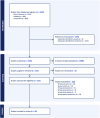The Use of 3D Printing as an Educational Tool in Orthopaedics
- PMID: 40443444
- PMCID: PMC12106196
- DOI: 10.2106/JBJS.OA.25.00062
The Use of 3D Printing as an Educational Tool in Orthopaedics
Abstract
Background: Three-dimensional (3D) printing has proven to be effective in orthopaedic surgery, improving both surgical planning and outcomes. Despite its increasing use in surgical programs, reviews evaluating its educational impact are sparse. Therefore, the aim of this review was to provide educators with evidence-based findings on 3D printing's potential in training junior surgeons, as well as discuss its benefits in enhancing patient communication.
Methods: A comprehensive search using PubMed and Web of Science databases was performed to identify articles related to orthopaedics, 3D printing, and education. After removing duplicates, 2,160 articles were screened, 152 underwent full-text review, and 50 met inclusion criteria. Articles discussed the impact of 3D-printed models on comprehension or surgical performance. Data on publication details, sample size, teaching focus, learning outcomes, costs, and conclusions were extracted. Learning effects in the control (didactic) and experimental (3DP) groups were compared.
Results: In fracture management training, studies demonstrated significantly improved fracture classification accuracy, surgical performance, and interobserver classification agreement with 3D models compared with didactic learning and traditional imaging modalities. These benefits were particularly evident in cases of complex fractures and junior trainees. In arthroscopy, 3D-printed simulators improved procedural accuracy and were more cost-effective than virtual reality simulators and cadaveric laboratory results. Three-dimensionally printed simulators were also assessed for skills related to spine surgery, in which trainees demonstrated clear learning curve improvements for pedicle screw placement and osteotomy techniques, as well as a better understanding of vital paraspinal structures. The application of 3D printing in patient education was equally promising, as it facilitated the process of informed consent, ultimately promoting shared decision making.
Conclusion: The use of 3D-printed models offers effective and customizable methods for developing essential surgical skills. Future research should focus on larger, more diverse study populations and should include long-term follow-up to better assess the impact of 3D printing on education and patient outcomes.
Copyright © 2025 The Authors. Published by The Journal of Bone and Joint Surgery, Incorporated. All rights reserved.
Conflict of interest statement
Disclosure: The Disclosure of Potential Conflicts of Interest forms are provided with the online version of the article (http://links.lww.com/JBJSOA/A829).
Figures
Similar articles
-
Publication trends and knowledge mapping in 3D printing in orthopaedics.J Clin Orthop Trauma. 2018 Jul-Sep;9(3):194-201. doi: 10.1016/j.jcot.2018.07.006. Epub 2018 Jul 30. J Clin Orthop Trauma. 2018. PMID: 30202148 Free PMC article. Review.
-
Are 3D-printed Models of Tibial Plateau Fractures a Useful Addition to Understanding Fractures for Junior Surgeons?Clin Orthop Relat Res. 2022 Jun 1;480(6):1170-1177. doi: 10.1097/CORR.0000000000002137. Epub 2022 Feb 28. Clin Orthop Relat Res. 2022. PMID: 35230277 Free PMC article.
-
Full-sized realistic 3D printed models of liver and tumour anatomy: a useful tool for the clinical medicine education of beginning trainees.BMC Med Educ. 2023 Aug 15;23(1):574. doi: 10.1186/s12909-023-04535-3. BMC Med Educ. 2023. PMID: 37582729 Free PMC article.
-
Applying a three-dimensional curved lumbar spine model to simulate surgery for training residents in pedicle screw insertion.Surg Radiol Anat. 2024 Dec 30;47(1):49. doi: 10.1007/s00276-024-03550-3. Surg Radiol Anat. 2024. PMID: 39738622
-
Systematic review and meta-analysis of 3D-printing in otolaryngology education.Int J Pediatr Otorhinolaryngol. 2022 Apr;155:111083. doi: 10.1016/j.ijporl.2022.111083. Epub 2022 Feb 18. Int J Pediatr Otorhinolaryngol. 2022. PMID: 35219038
References
Publication types
LinkOut - more resources
Full Text Sources
Miscellaneous

